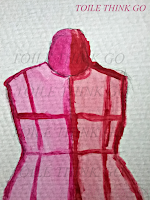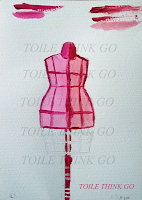Today, I'm reviewing the Acrylic that came out of the
126 Gift Art Set by Artist’s Loft Necessities. (There are only ten tubes in the case.
Unlike the set of 12, it doesn’t come with
yellow ochre and
raw umber).
I received the set in 2019. Over time, I have slowly used various things out of it. It wasn’t until recently that I used the acrylic. While my mom was trying to paint a glass ornament, I was trying it out on the paper that came with it. I immediately noticed how thin and transparent it brushed on. The paint dried horribly on the ornament and she ended up coving it with some of the other acrylics we have. Somehow, I managed to get something decent with my first painting (not pictured). Despite my first impression I wanted to try again. The next two painting are on Artist’s Loft Watercolor Pad (you can find that here).
 |
After I painted over with
other acrylics |
 |
| Original with Artist's Loft |
The first thing I dislike is that these don’t act like any acrylic I’m used to using. As I said above, it’s transparent. And no matter how much paint I picked up on the brush, it always painted thin. I even tried using a damp brush. On my second painting, it streaked badly (left). It became streakier when I tried to build up color. I even let it dry some before applying more color. Still, more streaks. I gave up and lazily filled in the hair. I wasn’t finishing it with these paints anyway.

Not everything was bad. With the next paintings, I changed the way I thought about the paints. Maybe like… a watercolor-acrylic? I started adding a lot of water to them, more than I would to reactivate watercolor. Additionally, I cut down on how many colors I mixed to get my skin tone from four to two. (Honestly, I have no idea if this really affected its performance. But, it did save on paint.)
I was able to layer the paint a bit better with it watered down. I also controlled the streaking some by doing the wet on wet technique. Despite being hard to layer and my gripe with streakiness, this turned out to be fine for how I paint hair. So that’s somewhat a plus.
For an attempt at fair comparison I did one more painting. The left side is Liquitex Basics. I used quinacridone magenta and titanium white. The right is Artist’s Loft Necessities. I used crimson red and titanium white. I did this for texture and opacity rather than color.
At the top of the paper is a thick and diluted swatch. I messed up the first swatch (top) for the Artist’s Loft because I accidently added more paint when I was trying to only do one swipe. So I did a smaller one under it. I went back to the paper that came with the set and it is more textured. I’m not sure exactly what type of paper it is. In the end, the Artist loft acrylic fared better but I still like Liquitex Basics (seems creamier). However, I enjoyed using it more on this paper. I struggled less with layering and getting some opacity.
Overall, it was difficult to work with and didn’t behave how I expected it to. Especially on smooth paper, glass, or primed canvas. But, still, I don’t think this is the worst paint ever. It would have ended up with a 2 1/2 if it wasn’t for me using heavily textured or porous surfaces –like salt dough and cold porcelain (a topic for another post). Who knows, maybe you’ll like it more than I did.
My Pros and Cons
Pro
- Doesn’t dry fast when thick on the pallet
- Dries somewhat quick on paper
- Fine if you don’t mind thin paint
Neutral
- I somewhat like it for painting hair
- Works fine on heavily textured or porous surfaces
Cons
- Transparent and thin
- Hard to layer, and sometimes waiting until mostly dry to get some layering
- Streaks easily
- Overall difficult to work with
- Small tubes
Thanks for reading.














